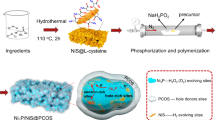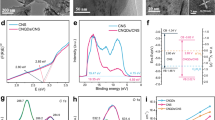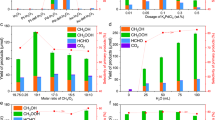Abstract
Methanol with 12.5 wt% H2 content is widely considered a liquid hydrogen medium. Taking into account water with 11.1 wt% H2 content, H2 synthesis from the mixture of water and methanol is a promising method for on-demand hydrogen production. We demonstrate an atomic-level catalyst design strategy using the synergy between single atoms and nanodots for H2 production. The PtCu–TiO2 sandwich photocatalyst achieves a remarkable H2 formation rate (2,383.9 µmol h–1) with a high apparent quantum efficiency (99.2%). Furthermore, the oxidation product is a high-value chemical formaldehyde with 98.6% selectivity instead of CO2, leading to a nearly zero-carbon-emission process. Detailed investigations indicate a dual role of the copper atoms: an electron acceptor to facilitate photoelectron transfer to Pt, and a hole acceptor for the selective oxidation of methanol to formaldehyde, thus avoiding over-oxidation to CO2. The synergy between Pt nanodots and Cu single atoms together reduces the activation energy of this process to 13.2 kJ mol–1.
This is a preview of subscription content, access via your institution
Access options
Access Nature and 54 other Nature Portfolio journals
Get Nature+, our best-value online-access subscription
$29.99 / 30 days
cancel any time
Subscribe to this journal
Receive 12 print issues and online access
$259.00 per year
only $21.58 per issue
Buy this article
- Purchase on Springer Link
- Instant access to full article PDF
Prices may be subject to local taxes which are calculated during checkout





Similar content being viewed by others

Data availability
All data are available in the manuscript or the Supplementary Information. Source data are provided with this paper.
References
Palo, D. R. Methanol steam reforming for hydrogen production. Chem. Rev. 107, 3992–4021 (2007).
Nielsen, M. et al. Low-temperature aqueous-phase methanol dehydrogenation to hydrogen and carbon dioxide. Nature 495, 85–89 (2013).
Cholewa, T., Semmel, M., Mantei, F., Güttel, R. & Salem, O. Process intensification strategies for power-to-X technologies. ChemEngineering 6, 109097 (2022).
Ruf, S., May, A. & Emig, G. Anhydrous formaldehyde by sodium catalysis. Appl. Catal. A Gen. 213, 203–215 (2001).
Bahmanpour, A. M., Hoadley, A. & Tanksale, A. Critical review and exergy analysis of formaldehyde production processes. Rev. Chem. Eng. 30, 583–604 (2014).
Christopher, P., Xin, H. & Linic, S. Visible-light-enhanced catalytic oxidation reactions on plasmonic silver nanostructures. Nat. Chem. 3, 467–472 (2011).
Wang, Q. et al. Scalable water splitting on particulate photocatalyst sheets with a solar-to-hydrogen energy conversion efficiency exceeding 1%. Nat. Mater. 15, 611–615 (2016).
Lee, B. H. et al. Reversible and cooperative photoactivation of single-atom Cu/TiO2 photocatalysts. Nat. Mater. 18, 620–626 (2019).
Zhang, C. & Tour, J. M. Atomic approaches towards stability. Nat. Catal. 1, 900–902 (2018).
Fei, H. et al. Single atom electrocatalysts supported on graphene or graphene-like carbons. Chem. Soc. Rev. 48, 5207–5241 (2019).
Shiraishi, Y., Sakamoto, H., Sugano, Y., Ichikawa, S. & Hirai, T. Pt–Cu bimetallic alloy nanoparticles supported on anatase TiO2: highly active catalysts for aerobic oxidation driven by visible light. ACS Nano 7, 9287–9297 (2013).
Luca, G., Ferri, D. & Selli, E. Effect of the CH3OH/H2O ratio on the mechanism of the gas-phase photocatalytic reforming of methanol on noble metal-modified TiO2. J. Catal. 280, 168–177 (2011).
Chiarello, G. L., Aguirre, M. H. & Selli, E. Hydrogen production by photocatalytic steam reforming of methanol on noble metal-modified TiO2. J. Catal. 273, 182–190 (2010).
Xie, S. et al. Visible light-driven C–H activation and C–C coupling of methanol into ethylene glycol. Nat. Commun. 9, 1181 (2018).
Luo, L. et al. Binary Au–Cu Reaction Sites Decorated ZnO for Selective Methane Oxidation to C1 Oxygenates with Nearly 100% Selectivity at Room Temperature. J. Am. Chem. Soc. 144(2), 740–750 (2022).
Luo, L., et al. Synergy of Pd Atoms and Oxygen Vacancies on In2O3 for Methane Conversion under Visible Light. Nat. Commun. 13, 2390 (2022).
Maeda, K. et al. GaN:ZnO solid solution as a photocatalyst for visible-light-driven overall water splitting. J. Am. Chem. Soc. 127, 8286–8287 (2005).
Lin, L. et al. Low-temperature hydrogen production from water and methanol using Pt/α-MoC catalysts. Nature 544, 80–83 (2017).
Byrne, C. et al. Effect of Cu doping on the anatase-to-rutile phase transition in TiO2 photocatalysts: theory and experiments. Appl. Catal. B Environ. 246, 266–276 (2019).
Zhang, Y., Harris, C. X., Wallenmeyer, P., Murowchick, J. & Chen, X. Asymmetric lattice vibrational characteristics of rutile TiO2 as revealed by laser power dependent Raman spectroscopy. J. Phys. Chem. C 117, 24015–24022 (2013).
Espinós, J. P. et al. Interface effects for Cu, CuO, and Cu2O deposited on SiO2 and ZrO2. XPS determination of the valence state of copper in Cu/SiO2 and Cu/ZrO2 catalysts. J. Phys. Chem. B 106, 6921–6929 (2002).
Raman, R. K. et al. Tailoring a Pt–Ru catalyst for enhanced methanol electro-oxidation. J. Power Sources 157, 45–55 (2006).
Briggs, D. in Handbook of Adhesion 2nd edn (ed. Packham, D. E.) Ch. 22, 621–622 (Wiley, 2005).
Ardelean, I., Peteanu, M., Ciceo-Lucacel, R. & Bratu, I. Structural investigation of CuO containing strontium-borate glasses by means of EPR and IR spectrometry. J. Mater. Sci. Mater. Electron. 11, 11–16 (2000).
Liu, J. et al. Enhancement of photochemical hydrogen evolution over Pt-loaded hierarchical titania photonic crystal. Energy Environ. Sci. 3, 1503–1506 (2010).
Yu, J., Hai, Y. & Cheng, B. Enhanced photocatalytic H2-production activity of TiO2 by Ni(OH)2 cluster modification. J. Phys. Chem. C 115, 4953–4958 (2011).
Xiao, S. et al. Copper nanowires: a substitute for noble metals to enhance photocatalytic H2 generation. Nano Lett. 15, 4853–4858 (2015).
Ou, G. et al. Tuning defects in oxides at room temperature by lithium reduction. Nat. Commun. 9, 1302 (2018).
Jin, J. et al. Anchoring ultrafine metallic and oxidized Pt nanoclusters on yolk-shell TiO2 for unprecedentedly high photocatalytic hydrogen production. Nano Energy 38, 118–126 (2017).
Zhang, Y. et al. Single-atom Cu anchored catalysts for photocatalytic renewable H2 production with a quantum efficiency of 56%. Nat. Commun. 13, 58 (2022).
Wang, H. Titanosilicate zeolite supported Pt nanoparticles with electronic metal-support interactions for efficient methanol steam reforming. Catal. Today 382, 42–47 (2021).
Sun, Z., Fang, S., Lin, Y. & Hu, Y. H. Photo-assisted methanol steam reforming on solid solution of Cu-Zn-Ti oxide. Chem. Eng. J. 375, 121909 (2019).
Dan-Hardi, M. et al. A new photoactive crystalline highly porous titanium(IV) dicarboxylate. J. Am. Chem. Soc. 131, 10857–10859 (2009).
Fregert, S. A simple method for the detection of fromaldehyde. Contact Dermat. 10, 132–134 (1984).
Hisatomi, T., Takanabe, K. & Domen, K. Photocatalytic water-splitting reaction from catalytic and kinetic perspectives. Catal. Lett. 145, 95–108 (2015).
Acknowledgements
We thank the Photoemission Endstation (BL10B) at the National Synchrotron Radiation Laboratory in Hefei and beamline BL11B of the Shanghai Synchrotron Radiation Facility for providing sufficient beamline time. H.W., X. Li, T.J.M., L.X. and J.T. thank the UK Engineering and Physical Sciences Research Council (EP/S018204/2), the Royal Society Newton Advanced Fellowship grant (NAF\R1\191163) and the Royal Society Leverhulme Trust Senior Research Fellowship (SRF\R1\21000153). L.X. and J.T. also thank the National Natural Science Foundation of China for a grant (22250710677).
Author information
Authors and Affiliations
Contributions
J.T. designed and supervised the entire project and oversaw all discussions. H.W. conducted the catalyst preparation, sample characterizations and activity tests. H.Q. carried out the EXAFS and fitted the data. X. Li contributed to the electron paramagnetic resonance discussion. T.J.M. helped to collect data and in the discussion of UV–visible–near-infrared diffuse reflectance spectra. S.J. carried out the density functional theory calculation, and X.Z. supervised the process. X.S. collected the Ti and O EXAFS data, and W.H. supervised the process. L.X. performed the aberration-corrected HAADF-STEM. S.W. collected all the TEM data. X. Liu, A.W. and T.Z. supervised the EXAFS data collection and fitting. The manuscript was written through collective contributions from all authors. All authors approved the final version of the manuscript.
Corresponding author
Ethics declarations
Competing interests
The authors declare no competing interests.
Peer review
Peer review information
Nature Materials thanks the anonymous reviewers for their contribution to the peer review of this work.
Additional information
Publisher’s note Springer Nature remains neutral with regard to jurisdictional claims in published maps and institutional affiliations.
Supplementary information
Supplementary Information
Supplementary Figs. 1–35, tables 1–7, caption for video 1 and references.
Supplementary Video 1
Hydrogen generation via PtCu–TiO2.
Supplementary Data
Statistical source data for supplementary figures and tables.
Source data
Source Data Fig. 1
Statistical source data.
Source Data Fig. 2
Statistical source data.
Source Data Fig. 4
Statistical source data.
Rights and permissions
Springer Nature or its licensor (e.g. a society or other partner) holds exclusive rights to this article under a publishing agreement with the author(s) or other rightsholder(s); author self-archiving of the accepted manuscript version of this article is solely governed by the terms of such publishing agreement and applicable law.
About this article
Cite this article
Wang, H., Qi, H., Sun, X. et al. High quantum efficiency of hydrogen production from methanol aqueous solution with PtCu–TiO2 photocatalysts. Nat. Mater. 22, 619–626 (2023). https://doi.org/10.1038/s41563-023-01519-y
Received:
Accepted:
Published:
Issue Date:
DOI: https://doi.org/10.1038/s41563-023-01519-y
This article is cited by
-
Photochemical tuning of dynamic defects for high-performance atomically dispersed catalysts
Nature Materials (2024)
-
Photocatalysts for steering charge transfer and radical reactions in biorefineries
Nature Synthesis (2024)


